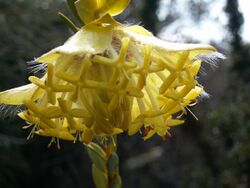Biology:Pimelea suaveolens
| Scented banjine | |
|---|---|

| |
| Pimelea suaveolens subsp. suaveolens near Albany | |
| Scientific classification | |
| Kingdom: | Plantae |
| Clade: | Tracheophytes |
| Clade: | Angiosperms |
| Clade: | Eudicots |
| Clade: | Rosids |
| Order: | Malvales |
| Family: | Thymelaeaceae |
| Genus: | Pimelea |
| Species: | P. suaveolens
|
| Binomial name | |
| Pimelea suaveolens Meisn.[1]
| |
| Synonyms[1] | |
|
Calyptrostegia suaveolens (Meisn.) Endl. | |
Pimelea suaveolens, commonly known as scented banjine,[2] is a slender shrub with large, rather hairy yellow inflorescences. It occurs in forest areas of the south-west of Western Australia from New Norcia to Albany.
Description
Pimelea suaveolens is an erect, spindly, often multi-stemmed shrub which grows to a height of 0.25–1.2 m (0.8–4 ft). The stems and leaves are glabrous and the leaves are arranged in opposite pairs, sword-shaped and 10–30 mm (0.4–1 in) long. The inflorescences are 30–40 mm (1–2 in) across and consist of many pale to deep yellow flowers surrounded by hairy, petal-like bracts and hang from the branches. Flowering occurs from June to October.[2][3][4]
Taxonomy
Pimelea suaveolens was first formally described in 1845 by Carl Meissner and the description was published in Lehmann's Plantae Preissianae from a specimen collected by James Drummond at Greenmount in 1839.[5][6] The Latin specific epithet suaveolens means "sweet-smelling".[7]
In 1988, Barbara Rye named two subspecies of P. suaveolens in the journal Nuytsia and the names are accepted at the Australian Plant Census:[8]
- Pimelea suaveolens subsp. flava Rye[9] that has green leaves;[8][10]
- Pimelea suaveolens Meisn. subsp. suaveolens[11] that has glaucous leaves.[8]
Distribution and habitat
Scented banjine grows on sand, sandy clay, gravel and laterite on undulating plains, flats, ridges and roadsides.[2] It grows between New Norcia and Albany in the Coolgardie, Avon Wheatbelt, Esperance Plains, Geraldton Sandplains, Mallee, Swan Coastal Plain, Jarrah Forest and Warren biogeographic regions.[12]
Conservation status
Pimelea suaveolens is classified by the Western Australian Government Department of Biodiversity, Conservation and Attractions as "not threatened".[2]
Use in horticulture
This species is not difficult to propagate from cuttings but is difficult to maintain in cultivation. "Good drainage and partial shade are important."[3]
References
- ↑ 1.0 1.1 "Pimelea suaveolens". Australian Plant Census. https://biodiversity.org.au/nsl/services/apc-format/display/70662. Retrieved 28 November 2020.
- ↑ 2.0 2.1 2.2 2.3 "Pimelea suaveolens Rchb.f.". FloraBase. Western Australian Government Department of Parks and Wildlife. https://florabase.dpaw.wa.gov.au/browse/profile/5266.
- ↑ 3.0 3.1 Wrigley, John W; Fagg, Murray (2013). Australian native plants (6th ed.). Chatswood, N.S.W.: Reed New Holland. p. 284. ISBN 9781921517150.
- ↑ Erickson, Rica (1982). Flowers and plants of Western Australia (Reprinted 1983 ed.). Sydney: Reed. p. 39. ISBN 058950116X.
- ↑ "Pimelea suaveolens". APNI. https://id.biodiversity.org.au/instance/apni/481364. Retrieved 12 February 2019.
- ↑ Meissner, Carl D.F.; Lehmann, Johann G.C. (1845). Plantae Preissianae Vol.1, No.4. Hamburg. pp. 603–604. https://www.biodiversitylibrary.org/page/498179#page/608/mode/1up. Retrieved 26 November 2017.
- ↑ Brown, Roland Wilbur (1956). The Composition of Scientific Words. Washington, D.C.: Smithsonian Institution Press. p. 773.
- ↑ 8.0 8.1 8.2 Rye, Barbara L. (1988). "A revision of Western Australian Thymelaeaceae.". Nuytsia 6 (2): 214–219. https://www.biodiversitylibrary.org/item/232337#page/90/mode/1up. Retrieved 28 November 2020.
- ↑ "Pimelea suaveolens subsp. flava". Australian Plant Census. https://biodiversity.org.au/nsl/services/apc-format/display/70670. Retrieved 28 November 2020.
- ↑ Corrick, Margaret G.; Fuhrer, Bruce A. (2009). Wildflowers of southern Western Australia (3rd ed.). Kenthurst, N.S.W.: Rosenberg Publishing. p. 211. ISBN 9781877058844.
- ↑ "Pimelea suaveolens subsp. suaveolens". Australian Plant Census. https://biodiversity.org.au/nsl/services/apc-format/display/70687. Retrieved 28 November 2020.
- ↑ Paczkowska, Grazyna; Chapman, Alex R. (2000). The Western Australian flora : a descriptive catalogue. Perth: Wildflower Society of Western Australia. p. 560. ISBN 0646402439.
Wikidata ☰ Q17582275 entry
 |

